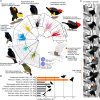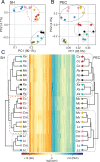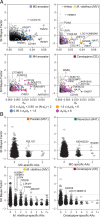Layered evolution of gene expression in "superfast" muscles for courtship
- PMID: 35363565
- PMCID: PMC9168950
- DOI: 10.1073/pnas.2119671119
Layered evolution of gene expression in "superfast" muscles for courtship
Abstract
Identifying the molecular process of complex trait evolution is a core goal of biology. However, pinpointing the specific context and timing of trait-associated changes within the molecular evolutionary history of an organism remains an elusive goal. We study this topic by exploring the molecular basis of elaborate courtship evolution, which represents an extraordinary example of trait innovation. Within the behaviorally diverse radiation of Central and South American manakin birds, species from two separate lineages beat their wings together using specialized “superfast” muscles to generate a “snap” that helps attract mates. Here, we develop an empirical approach to analyze phylogenetic lineage-specific shifts in gene expression in the key snap-performing muscle and then integrate these findings with comparative transcriptomic sequence analysis. We find that rapid wing displays are associated with changes to a wide range of molecular processes that underlie extreme muscle performance, including changes to calcium trafficking, myocyte homeostasis and metabolism, and hormone action. We furthermore show that these changes occur gradually in a layered manner across the species history, wherein which ancestral genetic changes to many of these molecular systems are built upon by later species-specific shifts that likely finalized the process of display performance adaptation. Our study demonstrates the potential for combining phylogenetic modeling of tissue-specific gene expression shifts with phylogenetic analysis of lineage-specific sequence changes to reveal holistic evolutionary histories of complex traits.
Keywords: behavioral physiology; manakin; molecular evolution; phylogenomics; transcriptomics.
Conflict of interest statement
The authors declare no competing interest.
Figures




References
MeSH terms
LinkOut - more resources
Full Text Sources

